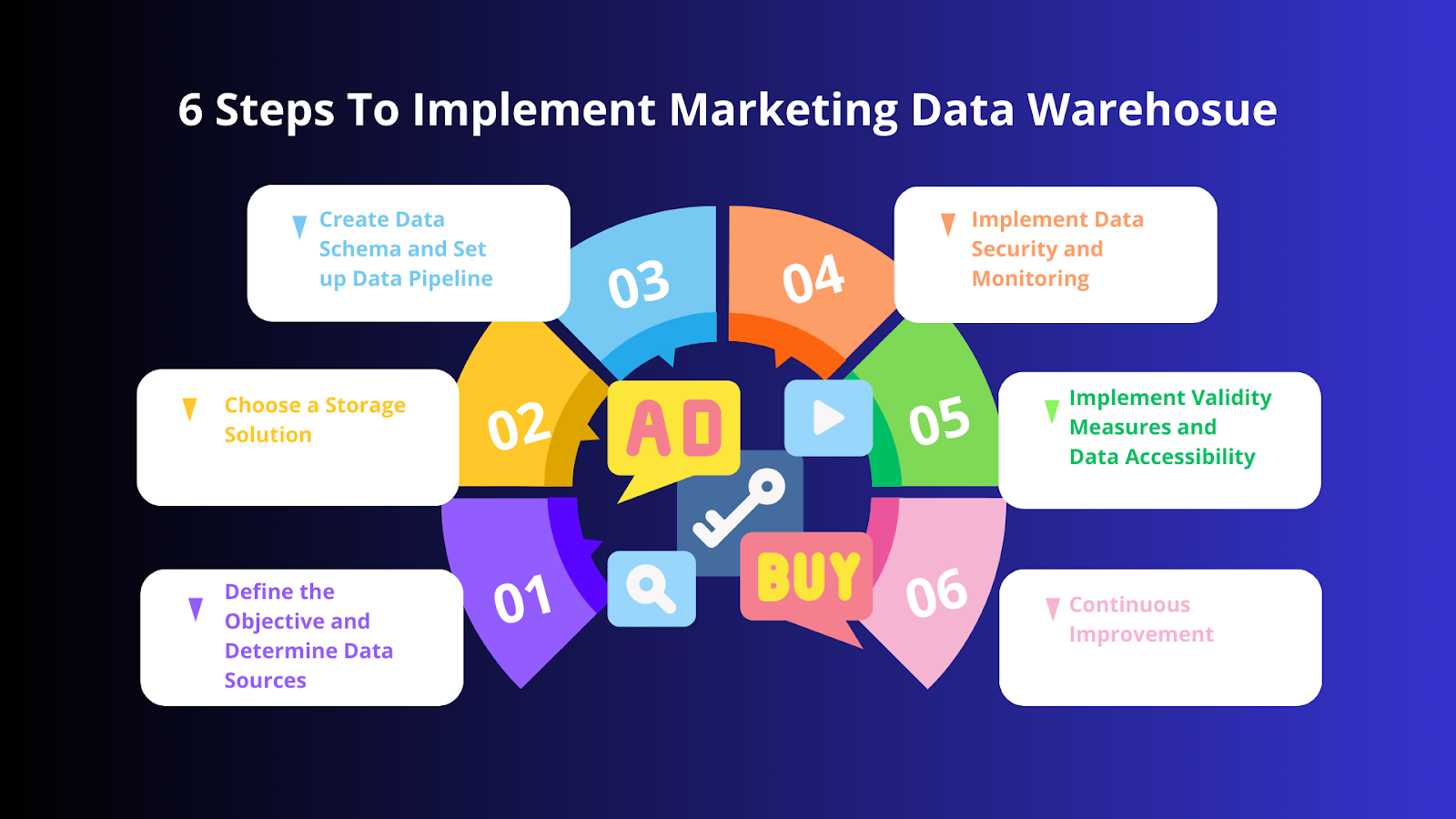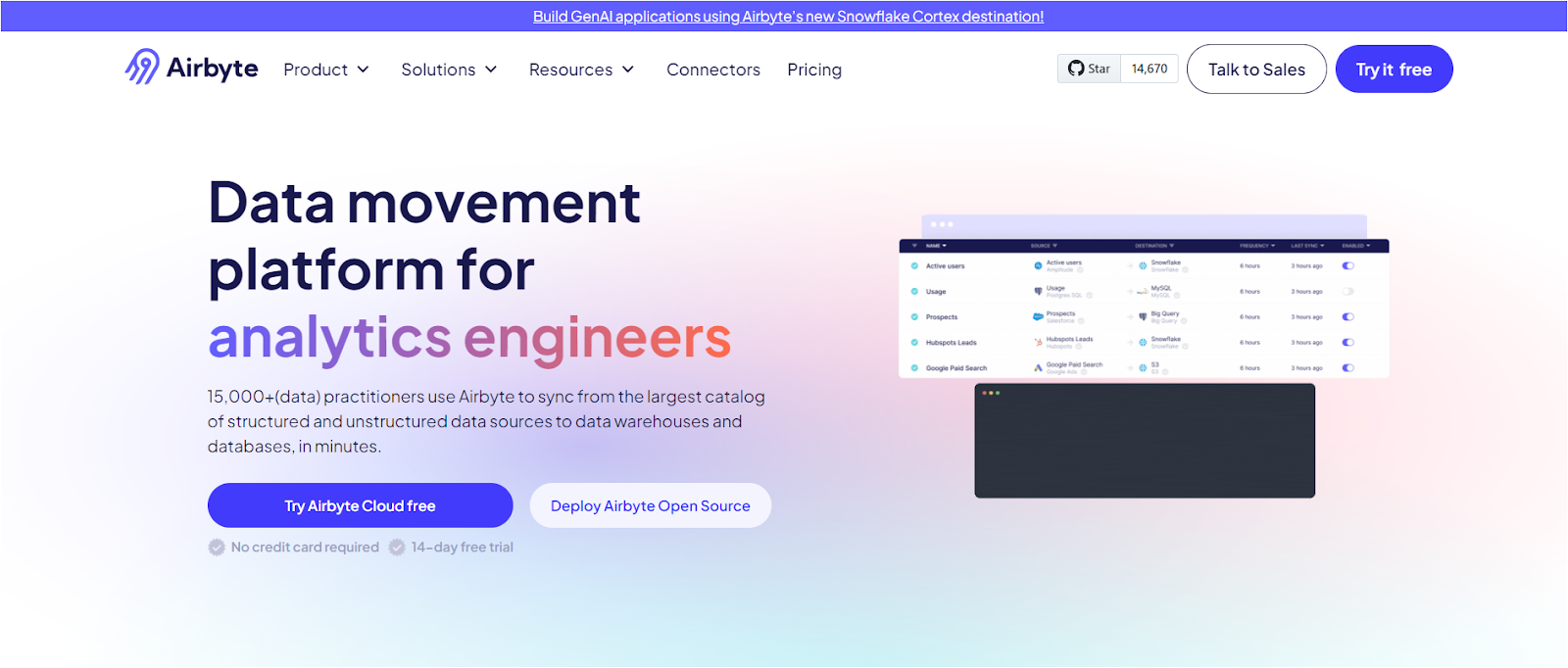What is Marketing Data Warehouse: Benefits & Design
Summarize this article with:
✨ AI Generated Summary
A marketing data warehouse centralizes large volumes of marketing data from diverse sources to enable deep analysis, improve data quality, and support targeted marketing strategies. Key benefits include scalability, enhanced data accuracy, integration with BI tools, and robust security measures. Leading solutions like Google BigQuery, Amazon Redshift, and Snowflake offer scalable, secure, and high-performance options tailored for marketing data needs.
- Consolidates data from advertising channels and CRM platforms for holistic marketing insights.
- Supports customizable data schemas and automated pipelines using tools like Airbyte.
- Ensures data security with encryption, access controls, and compliance adherence.
- Differs from databases and data lakes by focusing on structured, accurate marketing data for strategic decision-making.
- Selection criteria include integration capabilities, ELT compatibility, flexibility, cost efficiency, and security.
Marketing is an essential function that enables you to connect your products with customers. You must analyze consumer needs, apply sound marketing strategies, and collect the right data to create value for the organization and customers. To handle growing volumes of marketing data with finesse, you need to use a robust storage solution.
A marketing data warehouse is specifically designed to meet particular marketing needs, such as generating targeted marketing campaigns for better sales. The warehouse helps you increase accuracy in analyzing marketing data and enhances your organization's decision-making capabilities.
This article will explore marketing data warehouse, its benefits, architecture, setup, and more.
What is a Marketing Data Warehouse?
A marketing data warehouse is a repository that enables you to store large amounts of marketing data from diverse sources, including advertising channels and CRM platforms. This helps you consolidate the scattered data in one place and gives you a holistic view of your marketing performance.
Analyzing data through a marketing data warehouse allows your marketing department to enhance performance and implement effective strategies driving overall business growth. For instance, the marketing team can analyze the data in the warehouse to track conversion rates, marketing campaign performance, and more.
Why Do Businesses Need a Marketing Data Warehouse?
There are several benefits of a marketing data warehouse. Here are some of them:
- Scalability: The marketing data warehouse can be structured to accommodate large amounts of data produced daily. Its elastic storage empowers you to expand or contract the warehouse space according to your needs.
- Deep Analysis: Each customer has different preferences and buying behavior. The marketing data warehouse lets you analyze customer data profoundly, allowing you to build customized strategies more effectively.
- Accelerate Business Operations: You can integrate your marketing data warehouse with various BI tools to create dashboards and reports. This helps you derive actionable insights and accelerate your business operations.
- Data Quality: A marketing data warehouse centralizes the incoming data, making it easy to implement the data transformation and cleaning process. These operations enhance the quality of your datasets.
How to Setup a Marketing Data Warehouse?

Setting up a marketing data warehouse design requires proper planning and defining your business objectives. Here are steps to set up your marketing data warehouse:
Step 1: Define the Objective and Determine Data Sources
To build a solid foundation for a marketing data warehouse, you need to define and clearly outline your marketing goals. Your objectives could be to increase sales in a particular quarter or target a niche group of customers.
After this, determine the data sources from which you want to integrate your data into the warehouse. These sources include websites, social media, ad platforms, or CRM systems
Every successful strategy begins with defining clear objectives. At Milengo, we see this as the foundation for aligning efforts, enabling businesses to operate more effectively in global markets. By integrating data from various sources, companies can uncover valuable insights that drive smarter decisions. This clarity transforms marketing efforts when paired with the right localization strategies, ensuring messages resonate across languages and cultures. Success lies in combining focused goals with tools that bridge gaps and simplify complex processes.
Step 2: Choose a Storage Solution
To choose a storage solution for your marketing warehouse, you need to keep the following points in mind:
- Scalability
- Performance
- Data governance and security
You can choose an on-premise vs cloud data warehouse. Some of the examples include Teradata, Redshift, Google BigQuery or Snowflake.
Step 3: Create Data Schema and Set up Data Pipeline
A data schema provides structure to your incoming information by defining data formats and relationships among them. Create a schema to determine what data you can store in a data warehouse and which data needs transformation and cleaning before integration.
After creating a data schema, you need to design a robust data pipeline. Instead of manually mapping the data and handling APIs and scripts, you can use automated data integration tools such as Airbyte to develop a data pipeline. This tool simplifies data movement by helping you transform and load data into your marketing data warehouse with its 350+ pre-built connectors.

Some important features of Airbyte include:
- Airbyte caters to both technical and non-technical users. Non-technical users can leverage its intuitive no-code user interface, while developers can utilize its API, Terraform Provider, and PyAirbyte.
- Using Airbyte's Connector Development Kit, you can build custom connectors tailored to your specific requirements.
- To perform robust transformations, you can integrate Airbyte with dbt, a robust data transformation tool.
- Airbyte's schema change management feature allows you to specify how Airbyte should handle any schema changes in the source. This ensures your destination data is accurate and up-to-date.
Step 4: Implement Data Security, Monitoring, and Validity Measures
Implement robust security measures to protect customer data. The measures should include:
- Encrypting data at rest and transit,
- Strict role-based access controls,
- Restoration policies,
- Adherence to industry standards and privacy regulations.
Along with security measures, you should implement routine maintenance tasks. These tasks include operations like backups and updates. Regular monitoring helps you observe all the jobs and inspect data performance. It enables you to track the health of your data pipeline and tells you if any inconsistency or error is produced during integration.
You should set up validation measures to ensure data quality and accuracy during data ingestion. This helps you address anomalies promptly while maintaining data integrity.
Step 5: Continuous Improvement
After setting up the marketing data warehouse, you should identify areas for improvement and perform a gap analysis. It will help you adapt to changes and enhance the data infrastructure of your warehouse.
How Is a Marketing Data Warehouse Different from Other Storage Solutions?
Marketing data warehouses differ from other storage solutions because they focus on optimizing and analyzing marketing data. This enables you to implement effective marketing strategies according to customer needs. Here is how a marketing data warehouse is different from other storage solutions:
How to Choose the Best Marketing Data Warehouse Solution for Your Organization?
There are several essential factors that you should evaluate to ensure the storage solution aligns with business needs and long-term goals. Here are some of the factors to consider:
- Integration Capabilities: A robust marketing data warehouse must seamlessly connect with different data sources. It helps you streamline data collection and analysis.
- Compatible with ELT tools: ELT tools help you move your data from source to destination for data transformation and processing. By ensuring compatibility with ELT tools, such as Airbyte, you can optimize data workflow within your marketing data warehouse.
- Storage: Storage is essential for incorporating proper scalability and data retention within your marketing data warehouse. You should choose a warehouse solution that can accommodate large data volumes without compromising performance.
- Flexibility: The data storage solution should be flexible. It should support various data types and formats to handle diverse data easily. This ensures that the data infrastructure can evolve according to your business needs.
- Cost Efficiency: A marketing data warehouse must be able to manage and analyze data without incurring excessive computational and storage costs. You should look for a data solution that offers flexibility in pricing options. Some cost-efficient strategies offered by data warehouses include pay-as-you-go, subscription models, and tiered pricing based on usage.
- Data Security and Compliance: The marketing data warehouse solution must have robust security measures, such as fine-grained access controls, encryption, and more. These help secure your sensitive data from unauthorized access or data breaches, which is particularly crucial for SaaS marketing agencies handling client marketing information.
What Are Some of the Best Marketing Data Warehouse Solutions?
Many data warehouse solutions help you evaluate your business data. Here are some of the best storage warehouses that are widely used:
Google BigQuery

Google BigQuery is a broadly used serverless data warehouse offered by Google Cloud. It allows you to store, analyze, and gain insights from massive datasets in a highly scalable way.
Key Features of Google BigQuery:
- Integration: With BigQuery, you can seamlessly integrate with Google Cloud services, including Google Analytics or Google Ads. This helps you analyze your marketing data and track business performance.
- Machine Learning Capabilities: You can use BigQuery ML to create and implement machine learning models using SQL queries or Python code. This democratizes ML by making it accessible to a broader range of users.
Amazon Redshift

Amazon Redshift is a fully managed cloud-based data warehouse offered by AWS. It is designed for storing and analyzing enormous amounts of datasets, often from multiple sources. This empowers you to consolidate your data for in-depth marketing analysis.
Key Features of Amazon Redshift:
- Scalability: Amazon Redshift can handle petabytes of data. It allows you to scale up or down based on your marketing data needs.
- Massively Parallel Processing: Redshift uses MPP architecture to distribute data and queries across multiple nodes, enabling fast processing of large datasets.
Snowflake

Snowflake is a cloud-based data warehouse solution that offers a comprehensive suite of services for faster data storage, processing, and analytics. This data warehouse features auto-scaling and auto-suspend, enabling clusters to start, stop, or adjust based on your business needs.
Key Features of Snowflake:
- Performance: Snowflake utilizes a distributed architecture for high performance when querying large datasets.
- Security: Snowflake offers robust security measures that enable secure data sharing within or outside your organization.
Conclusion
A marketing data warehouse is a robust solution that allows you to consolidate all marketing data in one place. Within this data warehouse, you can study all aspects of your marketing data and enhance your decision-making process. It differs from other storage solutions due to its sole focus on managing and handling marketing data.
There are various data storage solutions from which you can choose to implement a marketing warehouse for your business. By selecting the data warehouse correctly, you can optimize your resources and get a competitive edge.
FAQs
Q. What is a data warehouse?
A data warehouse holds large amounts of business data in one place, which can be used for analysis and reporting.
Q. What is the purpose of a marketing data warehouse?
The purpose of the marketing data warehouse is to eliminate data silos in large datasets and help you make better decisions related to the marketing domain.
Q. What are the data sources from which data is ingested into a marketing data warehouse?
You can collect data from marketing channels such as LinkedIn ads, Google Ads, YouTube ads, or marketing platforms like Salesforce and AdRoll.

